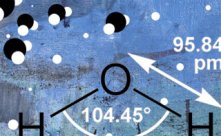Scientists look to the efficiency of nature to solve one of the biggest challenges in sustainably producing hydrogen fuel.

Without plants we’re done for. Our lives have always depended on the oxygen-generating process of photosynthesis, and if we hope to move away from our reliance on fossil fuels, our energy-hungry lifestyles might start depending on it too.
Photosynthesis is the light-fueled process by which plants convert carbon dioxide and water into energy stored as sugars. Now a team of scientists, led by David Milstein from the Weizmann Institute in Israel, has turned to this natural process for inspiration in generating hydrogen, which has enormous sustainable energy potential. The team has developed a technique for splitting water into hydrogen and oxygen using heat, natural light, and a novel organic-metallic complex.
“The two parts of this complex cooperate in separating the oxygen atom from the hydrogen atoms,” Milstein says. When they mixed water with this complex, one of its hydrogen atoms bonded to the organic component, and the remaining oxygen and hydrogen atoms bonded to the metal component. Heating the mixture then released hydrogen gas.
Capturing the resultant hydrogen at this point in the process would require a constantly new supply of water and catalyst for each repetition, which isn’t sustainable. Such inefficiency is unacceptable if industrial-scale production of hydrogen for energy is ever to be realized. In order to be cyclical, the technique must yield the same materials it began with: water and the organic-metallic complex, in this case. So the researchers at Weizmann looked for a way to reproduce water with the remaining hydrogen and oxygen atoms in their solution.
This problem of recombination has long troubled scientists seeking the elusive goal of efficient water splitting. Milstein’s team reduced this challenge to a question of generating oxygen. Through a series of reactions, oxygen generation in such solutions promotes the production of hydrogen peroxide — water with an additional oxygen atom — that then naturally decomposes into water.
Milstein says that generating oxygen is the most difficult step in water splitting. That’s part of why photosynthesis is compelling. In photosynthesis, Milstein says, water splitting occurs “quite efficiently.” It’s responsible for all the oxygen in the atmosphere.
What makes the team’s technique so special is their means of solving the recombination dilemma: designing their complex to produce oxygen. Just like plants. And during this recombination, the organic and metallic parts of the catalytic complex also recombine into their original configuration. The end result is a mixture ready for another heat-and-light-powered, hydrogen-generating reaction. “This is a clear mechanism for sunlight-driven water splitting,” Milstein says.
It’s possible, he notes, to repeat the process to get more hydrogen and oxygen. But the metallic-organic catalyst still needs work. Each time the procedure is repeated, the complex becomes less effective at splitting the water molecules.
So before this technique can become an economically viable way to produce hydrogen, additional research is necessary. The researchers have started to focus on simplifying their procedure and designing a more efficient and affordable catalyst. “We’re hoping to make progress,” Milstein says, “and once it looks more practical, then I think we could approach companies for funding.”
Though the individual steps of this procedure are quite different from photosynthesis, the two processes are, in principle, very similar. Both photosynthesis and Milstein’s procedure use sunlight to convert water into fuel — one a fuel for plant life, and the other, for modern life.
